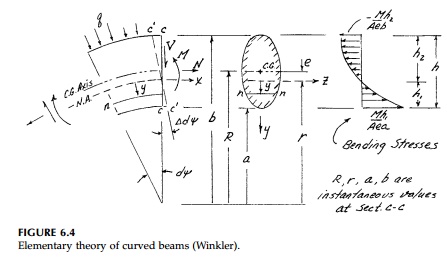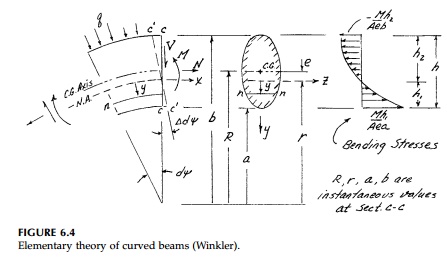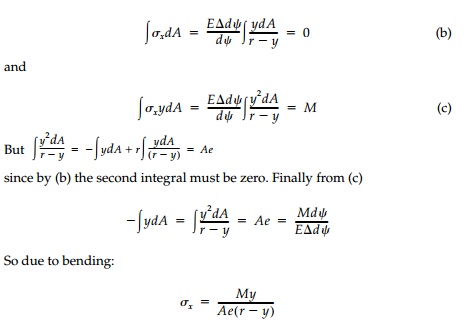Chapter: Civil : Principles of Solid Mechanics : Two Dimensional Solutions for Straight and Circular Beams
Simplified Analysis of Curved Beams

Simplified
Analysis of Curved Beams
As for straight beams, it is possible to develop a
strength-of-materials-type solution for curved beams from the assumption that
plane sections remain plain during flexure. We can then compare this Winkler
solution* to the more accurate results from elasticity theory to see when added
refinement is necessary.

Consider a differential
slice from a curved beam and call the tangent to the neutral axis at any
cross-section x, the radial coordinate, y, positive inward as
shown in Figure 6.4. Assume that:
a. The
transverse loading as well as the cross-section is symmetric and the bending
moment is in the plane of symmetry (the xy plane).
b. The
radial stress is neglected.
c. If
there is shear and/or normal force on the cross-section they induce shear
and/or normal stresses as in the elementary straight beam formulas.
d. Transverse sections remain plane (i.e., plane câ€'c rotates around the z axis an angle Î'dΨ)
While these are the same assumptions used for the elementary analysis of straight beams, for a curved beam the longitudinal fibers are not all the same original base length. Therefore, linear displacements produce nonlinear strains. For a layer of longitudinal fibers nâ€'n, a distance y from the neutral axis at radius r, the rotation of the cross-section Î'dΨ due to M gives:

which is hyperbolic,
not linear. For equilibrium, the neutral axis must be below the centroidal axis
(radius R) such that:

Thus for a curved beam,
the formulas for flexure with N and V by this Winkler analysis
are:

where e, the
distance from the centroidal axis to the neutral axis, is a property of the
cross-section such that (b) is satisfied. Formulas for various useful shapes
are given in many books. For the rectangular cross-section of unit thickness
necessary for comparison to an elasticity solution:

showing that only for
very deep beams is there an appreciable increase in the flexural stiffness.
Related Topics